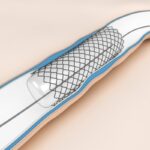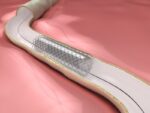Original title: Thinking Out of the Lumen: FFR Vs. Intravascular Imaging for MACE Prediction. Reference: Pedro R. Moreno et al. J Am Coll Cardiol, article in press. Intravascular imaging studies have shown that the lesions most likely to produce coronary events usually have modest luminal stenosis, large cap burden and thin fibrous cap. These plaques will evolve into a<a href="https://solaci.org/en/2013/09/05/intravascular-imaging-for-event-prediction-looking-beyond-the-lumen/" title="Read more" >...</a>
COURAGE patients who crossed branch.
This editorial comment was written by SOLACI.ORG and is based on an original article by Medscape which can be accessed free of charge at the bottom of this page. COURAGE patients (Patients in the Clinical Outcomes Utilizing Revascularization and Aggressive Drug Evaluation) who crossed from the optimal medical treatment branch to the revascularization branch within<a href="https://solaci.org/en/2013/09/03/courage-patients-who-crossed-branch/" title="Read more" >...</a>
2nd generation drug-eluting stents intended for left main coronary artery
Original title: Zotarolimus- versus Everolimus-Eluting Stents for Unprotected Left Main Coronary Artery Disease. ISAR-LEFT MAIN 2 Study. Reference: Julinda Mehilli et al. J Am Coll Cardiol, article in press. Improvements in 2nd generation drug-eluting stents led to increased efficiency and safety , however there is little information on these new platforms to treat left main coronary artery .<a href="https://solaci.org/en/2013/08/29/2nd-generation-drug-eluting-stents-intended-for-left-main-coronary-artery/" title="Read more" >...</a>
Zotarolimus-eluting stent in-stent restenosis
Original title: Clinical Outcomes of the Resolute Zotarolimus-Eluting Stent in Patients With In-Stent Restenosis Two-Year Results From a Pooled Analysis. Reference: Gert Richardt et al. J Am Coll Cardiol Intv 2013, article in press. Previous studies reported a target lesion revascularization (TLR) of 15% and target vessel (TVR) of 22% after a year of treating an injury-stent restenosis.<a href="https://solaci.org/en/2013/08/16/zotarolimus-eluting-stent-in-stent-restenosis/" title="Read more" >...</a>
Multislice computed tomography for bioresorbable scaffolds: the end of invasive diagnostic studies?
Original title: Multislice Computed Tomography Angiography for Non-invasive Assessment of the 18-Months Performance of a Novel Radiolucent Bioresorbable Vascular Scaffolding Device (ABSORB Trial). Reference: Koen Nieman et al. J Am Coll Cardiol, article in press. Metal stents revolutionized coronary angioplasty procedures; however, they are permanent prosthetic devices that make re intervention difficult and prolongue thrombosis risk. This problem<a href="https://solaci.org/en/2013/08/14/multislice-computed-tomography-for-bioresorbable-scaffolds-the-end-of-invasive-diagnostic-studies/" title="Read more" >...</a>
High doses of radiation also in peripheral procedures
Original title: Patient radiation exposure during percutaneous endovascular revascularization of the lower extremity. Reference: Einat Segal et al. Journal of Vascular Surgery. Article in press. Percutaneous endovascular revascularization is emerging as the first line treatment for peripheral artery disease for both intermittent claudication and chronic critical limb ischemia. Radiation doses for these interventions, usually prolonged, have not been<a href="https://solaci.org/en/2013/08/12/high-doses-of-radiation-also-in-peripheral-procedures/" title="Read more" >...</a>
Carotid angioplasty prior to central venous catheter. The best option to solve combined problems.
Original title: A Direct Comparison of Early and Late Outcomes with Three Approaches to Carotid Revascularization and Open Heart Surgery. Reference: Mehdi H. Shishehbor et al. J Am Coll Cardiol, article in press. The prevalence of severe carotid stenosis (> 80%) in patients planning to have a Central Venous Catheter (CVC) is estimated at between 6 and<a href="https://solaci.org/en/2013/08/08/carotid-angioplasty-prior-to-central-venous-catheter-the-best-option-to-solve-combined-problems/" title="Read more" >...</a>
Implanting a second valve and embolization are two complications that increase mortality
Original title: Determinats and Outcomes of Acute transcatheter Valve-in Valve Therapy or Embolization. Reference: Raj R Makkar, et al. J Am Coll Cardiol 2013;62:418-30 Percutaneous aortic valve implantation has proven to be feasible, safe and a successful follow up. Only in a few patients is the two-valve implantation necessary due to bad positioning or embolism but<a href="https://solaci.org/en/2013/08/06/implanting-a-second-valve-and-embolization-are-two-complications-that-increase-mortality/" title="Read more" >...</a>
DES versus Bare in primary angioplasty at five years. Initial advantage is reducing
Original: title Long-Term Outcome After Drug-Eluting VersusBare-Metal Stent Implantation in Patients WithST-Segment Elevation Myocardial Infarction. 5 Years Follow-Up From the Randomized DEDICATION (Drug Elution and DistalProtection in Acute Myocardial Infarction) Trial. Reference: Lene Holmvang et al. J Am CollCardiolIntv 2013, article in press. Primary angioplasty reduced mortality and reinfarction compared with thrombolytics in patients experiencing an ST<a href="https://solaci.org/en/2013/07/05/des-versus-bare-in-primary-angioplasty-at-five-years-initial-advantage-is-reducing/" title="Read more" >...</a>
Asymptomatic carotid injury, a disease not so silent
Original title: Association of the Recovery of Objective Abnormal CerebralPerfusion with Neurocognitive Improvement after CarotidRevascularization. Reference: Ching-Chang Huanget al. J Am CollCardiol 2013. Article in press. Cognitive impairment was observed in patients with severe asymptomatic carotid injury but a possible explanation for this is hyper-perfusion. Intuitively restored flow may improve neurocognitive capacity but so far studies have been<a href="https://solaci.org/en/2013/07/04/asymptomatic-carotid-injury-a-disease-not-so-silent/" title="Read more" >...</a>









